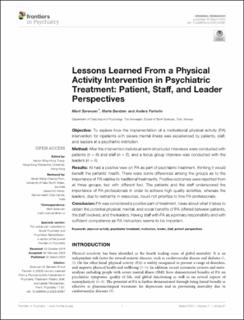| dc.contributor.author | Sørensen, Marit | |
| dc.contributor.author | Bentzen, Marte | |
| dc.contributor.author | Farholm, Anders | |
| dc.date.accessioned | 2020-10-20T13:40:43Z | |
| dc.date.available | 2020-10-20T13:40:43Z | |
| dc.date.created | 2020-08-24T14:43:23Z | |
| dc.date.issued | 2020 | |
| dc.identifier.citation | Frontiers in Psychiatry. 2020, 11, 87. | en_US |
| dc.identifier.issn | 1664-0640 | |
| dc.identifier.uri | https://hdl.handle.net/11250/2683971 | |
| dc.description | This is an open-access article distributed under the terms of the Creative Commons Attribution License (CC BY). The use, distribution or reproduction in other forums is permitted, provided the original author(s) and the copyright owner(s) are credited and that the original publication in this journal is cited, in accordance with accepted academic practice. No use, distribution or reproduction is permitted which does not comply with these terms. | en_US |
| dc.description.abstract | Objective: To explore how the implementation of a motivational physical activity (PA) intervention for inpatients with severe mental illness was experienced by patients, staff, and leaders at a psychiatric institution.
Method: After the intervention individual semi-structured interviews were conducted with patients (n = 6) and staff (n = 6), and a focus group interview was conducted with the leaders (n = 4).
Results: All had a positive view on PA as part of psychiatric treatment, thinking it would benefit the patients' health. There were some differences among the groups as to the importance of PA relative to traditional treatments. Positive outcomes were reported from all three groups, but with different foci. The patients and the staff underscored the importance of PA professionals in order to achieve high quality activities, whereas the leaders, due to restraints in resources, could not prioritize to hire PA professionals.
Conclusion: PA was considered a positive part of treatment. Ideas about what it takes to obtain the potential physical, mental, and social benefits of PA differed between patients, the staff involved, and the leaders. Having staff with PA as a primary responsibility and with sufficient competence as PA instructors seems to be important. | en_US |
| dc.language.iso | eng | en_US |
| dc.subject | physical activity | en_US |
| dc.subject | psychiatric treatment | en_US |
| dc.subject | motivation | en_US |
| dc.subject | leader | en_US |
| dc.subject | staff | en_US |
| dc.subject | patient perspectives | en_US |
| dc.title | Lessons learned from a physical activity intervention in psychiatric treatment: Patient, staff, and leader perspectives | en_US |
| dc.type | Peer reviewed | en_US |
| dc.type | Journal article | en_US |
| dc.description.version | publishedVersion | en_US |
| dc.rights.holder | © 2020 Sørensen, Bentzen and Farholm | en_US |
| dc.source.pagenumber | 11 | en_US |
| dc.source.volume | 11 | en_US |
| dc.source.journal | Frontiers in Psychiatry | en_US |
| dc.identifier.doi | 10.3389/fpsyt.2020.00087 | |
| dc.identifier.cristin | 1824851 | |
| dc.description.localcode | Institutt for idrett og samfunnsvitenskap / Department of Sport and Social Sciences | en_US |
| dc.source.articlenumber | 87 | en_US |
| cristin.ispublished | true | |
| cristin.fulltext | original | |
| cristin.qualitycode | 1 | |
